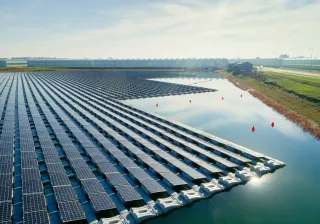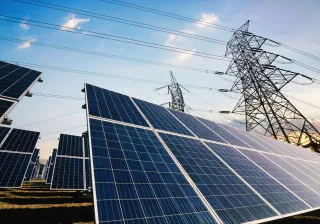The goal to achieve carbon neutrality remains a challenge, although we are holding more keys to the solution than ever before. What should we do, then? Various options and scenarios have been envisioned for a long time. We can identify solutions which could be promoted to benefit several different development trajectories in the world. We will highlight five solutions that we currently consider important, bearing in mind that, in order to solve the greatest challenge of our time, we will most likely need all the possible means to lead us in the right direction. The selection is based on the idea of a strong and rapid decarbonisation of electricity production.
Five solutions towards achieving carbon neutrality
- Electrification
- Demand side management and sector integration
- Hydrogen and synthetic hydrocarbons
- Geothermal
- System versatility
Electrification and particularly the related products and services that are already on the market, or being rapidly placed on the market, are particularly attractive. Functional and commercially available solutions include heat pumps and direct use of electricity in the production of process heat, to mention one example. On a broader perspective, electrification as a whole is a complex matter. It is divided into many smaller-scale solutions, most of which are related to heat production in different temperature ranges. In many cases, the use of electricity in different processes, either directly or through heat pumps, is a highly energy-efficient solution.
From the perspective of versatile use and variable generation of electricity, the demand side management and sector integration are emphasised. In order to achieve the maximum potential of these solutions, we need a wide range of cross-cutting expertise that we in Finland have a long tradition of: EPC contractors, engineering, platform providers and integrators in addition to equipment suppliers. It will be interesting to see who takes the role of a system integrator in the developing market. In the longer term, the bottlenecks of electrification include the increased need for storage, which can, however, be facilitated by many cross-sectoral solutions, as well as the availability and sustainability constraints of materials that are required for electrification, such as in the case of battery materials and the more familiar copper. In addition, when discussing electrification, it is important to consider price formation in electricity markets and the balance between consumption and production, which also favours solutions in a certain cost structure (which solutions are able to pay most for electricity). For example, in the transition phase, partial solutions with low investment costs can be attractive, but in the dynamic electricity market, demand affects pricing. It is also worth bearing in mind that processes with low operating costs are the ones that are likely to be kept running. The benefits can only be achieved with solutions that are in use.
Hydrogen and synthetic hydrocarbons follow somewhat behind the commercially available solutions, but play an important role in certain sectors. For example, there is an urgent need to come up with the first solutions for low-carbon drop-in transportation fuels particularly for long distance transport, where electrification poses more challenges than in urban transport. Hydrogen has featured strongly in the discussions, particularly from the European perspective. As an investment-intensive solution, it requires a broad range of measures aimed at a common goal. Hydrogen is an energy carrier, and therefore it does not offer a solution to the primary energy issue. On the other hand, hydrogen is an excellent emission-free energy carrier, which is also well-suited to provide large-scale and long-term energy storage once the necessary changes to the infrastructure have been made. With reasonable changes, many current solutions using fossil fuels can use clean electricity indirectly with the help of hydrogen produced through electrolysis. Hydrogen is particularly important in sectors that are difficult to decarbonise, such as industry and long-distance transport. In addition, the role of hydrogen is emphasised in continental Europe, which is highly dependent on natural gas.
Geothermal heating solutions have great potential also in Finland. In the near future, we will see which of the many technologies currently in the demonstration phase will prove to be the most functional, competitive and viable. In any case, there is a significant demand for efficient low-carbon solutions for centralised heat production in communities. At the same time, district heating systems will diversify. They will be connected to a variety of production units of different sizes, and their flexibility will increase to suit different actors. Geothermal heating has the potential to provide solutions of different sizes that guarantee secure heating, and why not cooling, all year round as needed.
System versatility provides flexibility in the changing world. This has been one of the advantages of the Finnish energy system for a long time. Instead of relying on a single solution, versatility enables a smooth change in the system now and in the future.
CCS, carbon capture and storage, has recently surfaced in the debate again. We are highlighting it here, outside the actual list, as a solution that should not be forgotten. Apart from blue hydrogen, CCS does not offer solutions for transport. However, in the light of the new objectives, CCS offers a solution for many other sectors that is reasonably priced compared to other options. Moreover, CCS in connection with the use of biomass is the only technological measure that can be deployed immediately and that enables the removal of carbon dioxide from the atmosphere on an industrial scale. CCS can also be seen as a late-stage solution, or a so-called emergency brake. Despite the substantial need for transport and storage infrastructure, it can be implemented as an end-of-pipe solution when the desired emission reductions have not been reached by other means. However, CCS should not be forgotten as an alternative, particularly from the point of view of global entities relying significantly more on fossil-based energy than Finland, or from the perspective of negative emissions.
In the fight against climate change, there is no wrong or right way to put out the fire, but all the measures at hand are needed. However, in addition to immediate economic and climate considerations, it is important to remember that the energy and resource efficiency of the solution, as well as the flexibility needed in a changing world, will become emphasised in the long term. When making choices either consciously or unconsciously, it should be remembered that many of the solutions depend highly on the selected path, particularly in terms of infrastructure development. Some can potentially leave a global imprint that is bigger than their share through cutting-edge technology, while some carry the risk of extensive investments in infrastructure development that will not be not suitable in the future. A crystal ball would be helpful here










